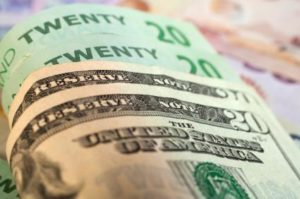 New Zealand dollar climbed to levels unseen in more than one week against its US counterpart on Wednesday, after a report showed that employers in New Zealand hired more employees than projected during the third quarter of the year, which add to the case that nations central bank may raise its benchmark interest rate from the current record low levels.
New Zealand dollar climbed to levels unseen in more than one week against its US counterpart on Wednesday, after a report showed that employers in New Zealand hired more employees than projected during the third quarter of the year, which add to the case that nations central bank may raise its benchmark interest rate from the current record low levels.
NZD/USD touched a session high at 0.8402 at 7:09 GMT, also the pairs highest point since October 24th, after which consolidation followed at 0.8384, gaining 0.25% for the day. Support was likely to be received at October 30th low, 0.8193, while resistance was to be met at October 24th high, 0.8446.
Statistics New Zealand reported earlier today that employment in the country rose 1.2% (27 000 new jobs) during the third quarter of the year compared to the second quarter, or the strongest increase since early 2007, significantly exceeding preliminary estimates of a 0.5% gain. In annual terms, employment increased 2.4% in Q3, again outstripping projections of a 1.6% gain.
At the same time, the rate of unemployment in New Zealand fell to 6.2% during the third quarter from 6.4% during the second. Experts had anticipated that unemployment will decrease to 6.1% in Q3.
Nations index of labor costs increased 0.4% in Q3, matching the climb rate recorded in the previous quarter, while expectations pointed a 0.5% gain.
This stronger growth in employment, accompanied by rising business confidence in New Zealand suggested that potential pressure may be present on wages and rate of inflation during the upcoming quarters, adding to the case that Reserve Bank of New Zealand Governor Graeme Wheeler and his team may consider a rate hike from the current record low level of borrowing costs in March next year. In October Wheeler indicated that borrowing costs will need to increase in 2014, as domestic demand picks up the pace and starts to drive inflation up.
“The labor-market statistics were very positive and another indicator suggesting that the Reserve Bank of New Zealand will need to raise interest rates probably in the first half of next year,” said Mike Jones, a currency strategist at Bank of New Zealand Ltd. in Wellington, cited by Bloomberg. “With rate hike expectations rising up again, the kiwi has been dragged higher.”
RBNZ Governor Wheeler has abstained from rate hikes this year in order to tackle what he has described as an overheated housing market in the country, underscoring low inflation and the risk that national currency will strengthen, a scenario which could obstruct exports.
Traders saw a 67% probability that the central bank will lift its benchmark rate by March, while late yesterday the odds of such a move was 51%, according to interest rate swaps data by Bloomberg. On the other hand, according to a Credit Suisse Group AG index also based on swaps, the Reserve Bank of New Zealand will probably add 81 basis points to the current benchmark interest rate of 2.50% over the next 12 months.
Meanwhile, the US dollar found strong support against peers yesterday, after the Institute for Supply Management (ISM) reported that the non-manufacturing PMI for the United States climbed to a reading of 55.4 in October from 54.4 in September, while preliminary estimates pointed a slow down to 54.0 in October. This result indicated that business entities in the country were looking beyond the political impasse that led to 16 days of partial government shutdown.
Elsewhere, the kiwi dollar was steady against the euro, with EUR/NZD cross ticking up a mere 0.01% on a daily basis to trade at 1.6116 at 8:06 GMT. AUD/NZD pair was losing 0.10% to trade at 1.1360 at 8:08 GMT.





